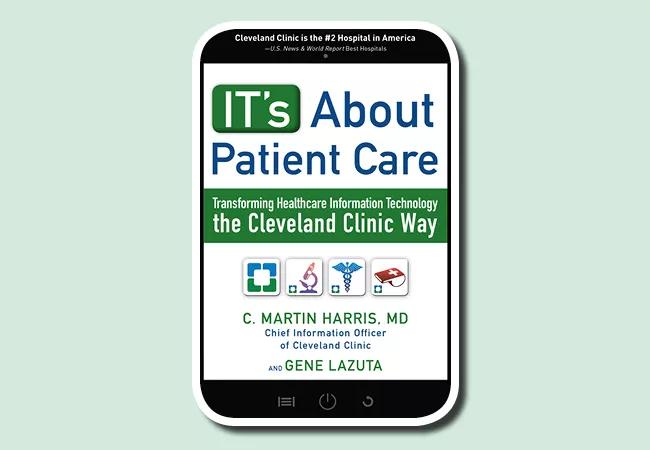New book reveals Cleveland Clinic’s successful IT model

In just 30 years, information technology (IT) has profoundly changed healthcare. Electronic medical records, online second opinions, real-time virtual visits, eHospital critical care monitoring — it’s just the beginning of how IT systems are enhancing healthcare delivery in the 21st century, says C. Martin Harris, MD, MBA.
Cleveland Clinic is a non-profit academic medical center. Advertising on our site helps support our mission. We do not endorse non-Cleveland Clinic products or services. Policy
Dr. Harris has been at the forefront of integrating advanced technology and compassionate patient care at Cleveland Clinic for 20 years. Under his leadership, Cleveland Clinic became one of the largest academic medical centers in the world to adopt electronic medical records across the enterprise. He then led efforts to make those records accessible to patients, empowering people to take more control of their own healthcare.
Dr. Harris shares that journey in his new book, IT’s About Patient Care: Transforming Healthcare Information Technology the Cleveland Clinic Way, co-edited by Gene Lazuta, Senior Director of Strategic Communication in Cleveland Clinic’s Division of Information Technology.
IT’s About Patient Care reveals Cleveland Clinic’s proven model of healthcare IT and demonstrates how it powers the No. 2 U.S. health system’s clinical and business engine. Go behind the scenes to see how Cleveland Clinic caregivers have executed their IT strategy in a working environment and how patients have benefitted.
Learn how your practice can do the same, using IT to:
“Long before the Affordable Care Act catalyzed a digital revolution in healthcare, Dr. Harris and his colleagues at Cleveland Clinic were leading the way in technology-enabled, integrated, patient-centric care designed to deliver optimal clinical outcomes,” says Dana Mead, a strategic advisor at Kleiner Perkins Caufield & Byers. “IT’s About Patient Care leverages these experiences to provide a uniquely informed view of what’s next in Healthcare IT.”
According to Dr. Harris, IT will remain key to making high-quality healthcare more affordable and accessible at Cleveland Clinic and medical practices around the world. He predicts an “Internet of Healthcare” — a virtual network of clinicians, educators, medical device manufacturers, pharmaceutical companies, insurance providers and other medical industry stakeholders.
“The future of healthcare is on your computer, your phone, your tablet, your network and the World Wide Web,” says Dr. Harris. “By connecting patients with caregivers ― and caregivers with each other ― we will be better equipped to diagnose conditions, recommend treatments and monitor patients in ways that weren’t possible 10 years ago.”
IT’s About Patient Care was published by McGraw-Hill Education as part of the Cleveland Clinic Way series. Other books in the series include:
Books in the Cleveland Clinic Way series are available for purchase in print or eBook at amazon.com or wherever books are sold.
Learn to become a physician leader with Cleveland Clinic Global Executive Education programs, including The Cleveland Clinic Way: Intensives, Samson Global Leadership Academy and the Executive Visitors’ Program.

Cleveland Clinic’s roadmap to recovering critical digital assets stems from strategic planning and preparedness

The Friends of Cybersecurity program bridges innovative technology solutions with mitigating security risks

Cleveland Clinic’s Information Technology Apprenticeship Program expands skill set while leading to meaningful employment

Protecting patient data and privacy while preventing unnecessary risks

While logistical questions remain about RPM, its benefits for both patients and caregivers are abundantly clear

Telehealth aids in treatment of fibromyalgia and median arcuate ligament syndrome

Rates of CR eligibility high and internet access low among older patients in rural areas

The infant fever care path is an interactive, step-by-step tool within the electronic health record that reduces high variability among standard practices to ensure safe, quality care at all Cleveland Clinic locations